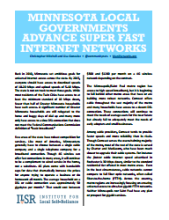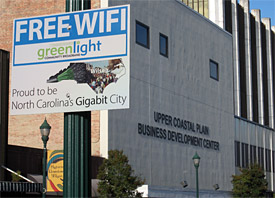
Fast, affordable Internet access for all.

Fiber to the Home

 "We had to choose an area that could offer a low cost of doing business, while delivering an infrastructure better than that of other states and countries," wrote Mr. Kalinoski, a three-time, award nominee for his special effects contributions to Black Swan and LOST, the Final Season.
"We had to choose an area that could offer a low cost of doing business, while delivering an infrastructure better than that of other states and countries," wrote Mr. Kalinoski, a three-time, award nominee for his special effects contributions to Black Swan and LOST, the Final Season.
Westminster's FTTP pilot project continues to blossom. We recently heard from Dr. Robert Wack, one of the local leaders of the project.
Engineering, the first phase, is almost completed with bids for construction soon to be solicited.
Even before any fiber is in the ground, Westminster is feeling the positive economic development effects from the network. According to Dr. Wack, Carlisle Etcetera, a women's fashion clothing company, will be relocating from New York City to Westminster. Carlisle will bring its distribution and data centers because it will have access to the next generation fiber network.
The local Industrial Development Authority is an official supporter of the project and will contribute local funds for capital costs.
In addition to price hikes, promotion cuts, the new gateway rental fee and the activation fee, Verizon also recently started charging users for the backup batteries in their ONT units, first charging users for backup battery replacement, then charging users to get any backup battery in the unit to begin with.Anytime you hear someone arguing that munis should only be able to build their own networks where the private sector absolutely refuses, recall that community owned networks are not simply a consolation prize, they are often superior. Better customer service, lower rates over the long term, and more likely to invest in upgrades as needed - there is no good reason to condition this investment on the refusal of some other distant company to provide an inferior alternative.
 And it has, even for young entrepreneurs elsewhere in the state. For a tech entrepreneur like Dan Holt from Wake Forest, renting space at this Wilson-based incubator lets him be part of the future, and to experience the possible which is impossible at his home in Wake Forest only 30 miles away. Dan is a self-described techie for a local Raleigh defense subcontractor but he likes to be known as founder of the Wake Forest Fiber Optic Initiative.
And it has, even for young entrepreneurs elsewhere in the state. For a tech entrepreneur like Dan Holt from Wake Forest, renting space at this Wilson-based incubator lets him be part of the future, and to experience the possible which is impossible at his home in Wake Forest only 30 miles away. Dan is a self-described techie for a local Raleigh defense subcontractor but he likes to be known as founder of the Wake Forest Fiber Optic Initiative.In partnership with the Center for Popular Democracy, we have created a new policy brief: Building Community Broadband Access. We offer examples of communities that have acted to improve access by using smart strategies that facilitate community owned networks.
This fact sheet provides information to legislators, advocates, or concerned citizens who want to educate others about the benefits of publicly owned networks. This is the latest in our growing collection of convenient, compact, and instructive fact sheets.
The Center for Popular Democracy works with a long list of local, state, and national groups to exercise grass-roots democracy.
The Sun Prairie City Council met on January 14th to discuss a possible investment in a municipal fiber network. Thank you to local resident Jonathan Kleinow for alerting us to developments in the south central Wisconsin town.
The Star published an article about the meeting in which The Motive Group presented information to the Committee of the Whole. According to the story, the consulting firm has been working with Sun Prairie Utilities for a year to find ways to improve local connectivity and spur economic development with fiber. The community is considering the possibilities of a triple-play FTTH network for the areas 30,000 residents.
Sun Prairie Utilities solicited responses to a community survey. They received 700 responses with 88% in favor of a fiber investment.
From the article:
The recommended plan put for[th] by The Motive Group has a total cost of near $27 million, with $21 million of that as year-one capital expenditures to serve roughly 13,550 homes and businesses in the city.
Budgeted in the initial year's expense total is $11 million for aerial and underground construction and equipment.
Once the fiber system is operational and available for customers, [The Motive Group's Beth] Ringley said projections show $9.97 million in annual operating revenue by year 20 of the system to go along with expenses of $1.26 million.
By year 20, total assets are projected to be at $27.16 million, with total cash at $12.56 million.
Councilman Jon Freund commented that he was opposed to the idea at first but that he now believes Sun Prairie Utilities and the City could partner to distinguish the community. From the article:
“Technology has become a greater and greater need for both businesses and residents,” Freund continued. “This is an opportunity for us to basically differentiate Sun Prairie from all the other communities in Dane County.”
...
He added that fiber installation would “put Sun Prairie on the leading edge” for economic development and local and long-distance education opportunities.
The Logan Journal recently reported that the Russellville Electric Plant Board (EPB) now offers gigabit service to local businesses. The article notes that Net Index, an online tool to measure download and upload speeds, recognizes EPB as the first Gig city in Kentucky. To learn more about the community and its network, we talked with Robert White, General Manager of EPB.
The community of 7,000 is the county seat of south central's Logan County. Russellville is located in the center of several other larger communities: Nashville, Bowling Green, Hopkinsville, and Clarksville, Tennessee. Manufacturing has been a large part of the local economy for generations, but community leaders recognize the vulnerability of a narrow economic base. In order to encourage a versatile economy, Russellville invested in its telecommunications utility.
The community wants to encourage small business while simultaneously providing manufacturers the connectivity they need. Leadership sees the ability to remain competitive directly tied to their network. In addition to the economic development opportunities a fiber network can provide, communities like Russellville rely on electricity revenue from large consumers. Retaining the large electric consumers that also provide jobs in the community is a must.
Russellville's electric utility created a strong advantage when it was time to venture into telecommunications. EPB had already established a strong relationship with its Russellville customers, says White, and locals felt they could trust their municipal electric provider.